LAB REPORT
Science and Technology Making Headlines
June 1, 2018

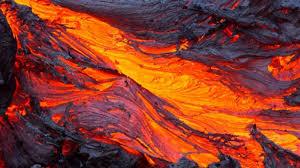
Magma could be tapped as a source of new clean energy.
Magma could erupt into clean energy
A new source of clean energy could be coming from a volcano near you.
Placing instruments in a magma chamber and extracting samples of its quenched contents could allow researchers to finally unravel the mysteries of how magma melts, crystallizes and flows. Such discoveries could lead to better eruption predictions, and perhaps someday enable people to tap magma's vast stores of heat as a source of clean energy.
The most obvious concern for many people is that drilling into magma could trigger an eruption. That educated guess may not absolve them of liability, however, because after researchers drill into an active volcano, the public might be quick to blame the drilling project for all future eruptions, said Charles Carrigan, a geophysicist at Lawrence Livermore National Laboratory and part of the Krafla Magma Testbed team.

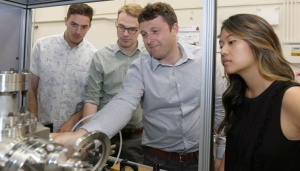
Lawrence Livermore National Laboratory researchers are part of a team that has successfully designed, built and tested a portable diagnostic machine, a common metal 3D printing approach. The researchers hope the instrument will provide insights into the causes of defects in 3D printed parts. Photo by Julie Russell/LLNL
Finding the flaws in 3D
Many facilities are putting forth significant resources to determine why flaws in metal 3D printed parts occur, and how to stop them -- perhaps none more so than the researchers at Lawrence Livermore. LLNL teamed up with scientists from Ames Laboratory and the SLAC National Accelerator Laboratory to use X-rays to study the metal 3D printing process and figure out where these flaws come from, and how they can be prevented.
The DOE’s Energy Efficiency and Renewable Energy (EERE) Advanced Manufacturing Office is funding the multi-year partnership between the three laboratories, an offshoot of its annual National Laboratories Big Ideas Summit (BIS) that facilitates strategic technical planning and collaboration through the national laboratory complex.
Adoption of metal 3D printing has been slow in several industries, such as aerospace and automotive, because part quality and certification cannot be anything less than perfect for these critical parts. LLNL researchers have conducted multiple experiments to pull the covers back on many complex mechanisms that can cause defects to form in metal parts, and this latest is a more direct examination of what factors lead to these defects, and how to avoid these flaws.

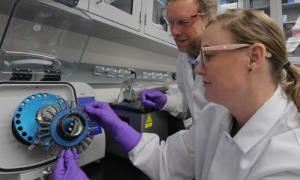
LLNL scientists are using proteins found in human bones for identification.
Making bones about identification
When a team of researchers led by Lawrence Livermore developed a new biological identification method that exploits information encoded in proteins, they thought it could have multiple applications. Nearly two years later, they’ve turned out to be right.
Last year, LLNL scientists announced they had developed a science-based, statistically validated way to use protein markers from human hair to identify people and link individuals to evidence.
Now they’ve found a second way to use protein markers from human tissue for identification -- this time from bones. “One of the most exciting aspects of this research is that it seeks to provide a completely new objective methodology for human identification,” said LLNL chemist Brad Hart, director of LLNL’s Forensic Science Center.

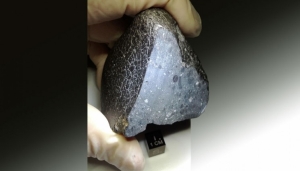
Martian meteorite Northwest Africa (NWA) 7034, nicknamed "Black Beauty," weighs approximately 11 ounces (320 grams). Credit: Carl Agee/University of New Mexico.
Meteorite dives into red planet’s history
A tiny Martian meteorite nicknamed “Black Beauty” has provided scientists with unprecedented insight into ancient processes that shaped the red planet’s surface. Discovered in the Sahara Desert and designated Northwest Africa (NWA) 7034, the Martian rock weighs no more than 320 grams -- but its extreme age and unusual composition have fascinated researchers since it was unearthed in 2011.
At approximately 4.4 billion years old, it contains a variety of different minerals from the planet’s crust, and scientists think it is the only known fragment that provides a representative sample of the average Martian surface.
As a result, a research team, which includes Lawrence Livermore cosmochemist Bill Cassata, set out to establish what this tiny rock could tell them about a major event that happened deep in Mars’ history -- the division of the heavily cratered southern highlands from the smoother plains of the northern lowlands.
The scientists said it exemplifies how dating systems can be used to “tease out” the history of rock samples, and by extension the planets they came from, over billions of years.

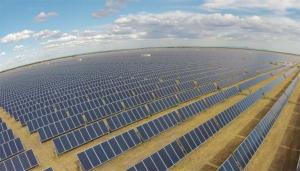
Americans used more solar energy in 2017 compared to 2016.
The chart that explains everything
Every year Lawrence Livermore National Laboratory produces Sankey diagrams of American energy flows, which are “single-page references that contain quantitative data about resource, commodity and byproduct flows in a graphical form.” The chart that explains everything shows exactly where our energy is coming from and where it is going.
This year's graph shows some improvements over 2016; solar power is up, from .587 quads to .775 quads (a quad is a trillion BTUs). Still tiny, but growing almost 40 percent in a year. Wind is up too, while both coal and natural gas are down slightly. If LLNL still did carbon graphs, it would show a slight decarbonizing of the electricity supply.
But the country is still burning more energy in total, and the increase in petroleum use is greater than the reduction in coal and gas consumption.





